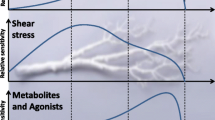Abstract
The appearance of a number of reports that CO2 tensions in the alveoli may exceed those in the pulmonary artery and vein have led to several hypotheses which are intended to explain such a gradient [17, 11, 18, 8]. Much attention has been given to the proposal of Gurtner et al. that this phenomenon could be explained on the basis of a charged membrane hypothesis [11, 13]: Hydrogen ions are dissociated from serum protein molecules under the influence of the negative charge on the endothelial cell surfaces and they are attracted to the capillary wall. Bicarbonate ions are repelled from the endothelium but at a slower rate. Consequently carbonic acid concentrations are elevated and CO2 is formed in the region near the capillary wall and diffuses into the alveoli, raising alveolar \({{\text{P}}_{C{O_2}}}\).
Access this chapter
Tax calculation will be finalised at checkout
Purchases are for personal use only
Similar content being viewed by others
References
Effros RM (1972) Pulmonary capillary carbon dioxide gradients and the Wien effect. J Appl Physiol 32: 221–222
Effros RM (1973) Red cells and CO2 gradients within pulmonary capillaries. J Appl Physiol 34: 740
Effros RM (1978) Pulmonary carbonic anhydrase and the conversion of plasma bicarbonate to carbon dioxide. In: Fitzgerald RS, Gautier H, Lahiri S (eds) The regulation of respiration during sleep and anesthesia. Plenum Press, New York, pp 255–268
Effros RM (1978) Pulmonary carbonic anhydrase and the release of carbon dioxide from the blood. Trans Assoc Am Phys Phil 91: 186–196
Effros RM, Weissman ML (1978) Carbonic anhydrase activity of cat hindleg. Physiologist 21: 33
Effros RM, Chang RSY, Silverman P (1978) Acceleration of plasma bicarbonate to carbon dioxide by pulmonary carbonic anhydrase. Science 199: 427–429
Filley GF, Heineken FG (1976) A blood gas disequilibrium theory. Br J Dis Chest 70: 223–245
Forster RE (1969) The rate of CO2 equilibration between red cells and plasma in CO2. In: Forster RE, Edsall RT, Otis AB, Roughton FJW (eds) Chemical, biochemical and physiological aspects. NASA SP-188, Washington DC, pp 275–284
Forster RE (1977) Can alveolar PCO2 exceed pulmonary end-capillary \({{\text{P}}_{C{O_2}}}\)? J Appl Physiol 42: 326–328
Forster RE, Crandall ED (1975) Time course of exchanges between red cells and extracellular fluid during CO2 uptake. J Appl Physiol 38: 710–718
Goldsmith HL (1968) Microrheology of blood cell suspension. J Gen Physiol 52: 5s - 28s
Gurtner GH (1972) Nonequilibrium steady-state differences in partial presence of CO2 and in concentration of weak acids and bases between blood and tissue. Biophys J 12: 597–608
Gurtner GH (1973) Energy requirements for intracapillary \({{\text{P}}_{C{O_2}}}\) gradients. J Appl Physiol 34: 740
Gurtner GH, Song SH, Farhi LE (1969) Alveolar to mixed venous \({{\text{P}}_{C{O_2}}}\) difference under conditions of no gas exchange. Respir Physiol 7: 173–287
Hill EP, Power GG, Lonzo LD (1973) Mathematical simulation of pulmonary O2 and CO2 exchange. Am J Physiol 224: 904–917
Hill EP, Power GG, Gilbert RD (1977) Rate of pH changes in blood plasma in vitro and in vivo. J Appl Physiol 42: 928–934
Hochmuth RM, Marple RN, Sutera SP (1970) Capillary bllod flow. I. Erythrocyte deformation in glass capillaries. Neurovasc Res 2: 409–419
Jones NL, Campbell EJM, Edwards RHT, Wilkoff WG (1969) Alveolar-to-blood \({{\text{P}}_{C{O_2}}}\) difference during rebreathing in exercise. J Appl Physiol 27: 356–360
Lazio G, Clark TJH, Pope H, Campbell EJM (1971) Differences between alveolar and arterial \({{\text{P}}_{C{O_2}}}\) during rebreathing experiments in resting human subjects. Respir Physiol 12: 36–52
Miyamoto T, Moll W (1971) Measurements of dimensions and pathway of red cells in rapidly frozen lungs in situ. Respir Physiol 12: 141–156
Roughton FJW (1959) Simultaneous chemical reaction velocity in hemoglobin solutions and red cell suspensions. Prog Biophys Biophys Chem 9: 55–104
Sawyer PN, Himmelfarb EH (1965) Studies of streaming potentials in large mammalian blood vessels in vivo. In: Sawyer PN (ed) Biophysical mechanisms in vascular haemeostasis and intravascular clotting. Appleton-Century Crafts, New York, pp 69–79
Seaman GVP (1975) Electrokinetic behavior of red cells. In: Mac N Surgenor F (ed) The red blood cell, 2nd ed. Academic Press, London New York pp 1135–1229
Silverman DN, Tu C, Wynns GC (1976) Depletion of 18O from C18O2 in erythrocyte suspensions. The permeability of erythrocyte membrane to CO2. J Biol Chem 251: 4428–4436
Sirs JA (1970) The interaction of carbon dioxide with the rate of exchange of oxygen by red cells. In: Hershey D (ed) Blood oxygenation. Plenum Press, New York, pp 116–136
Author information
Authors and Affiliations
Editor information
Editors and Affiliations
Rights and permissions
Copyright information
© 1980 Springer-Verlag Berlin Heidelberg
About this paper
Cite this paper
Effros, R.M. (1980). Intracapillary CO2 Gradients. In: Bauer, C., Gros, G., Bartels, H. (eds) Biophysics and Physiology of Carbon Dioxide. Proceedings in Life Sciences. Springer, Berlin, Heidelberg. https://doi.org/10.1007/978-3-642-67572-0_39
Download citation
DOI: https://doi.org/10.1007/978-3-642-67572-0_39
Publisher Name: Springer, Berlin, Heidelberg
Print ISBN: 978-3-642-67574-4
Online ISBN: 978-3-642-67572-0
eBook Packages: Springer Book Archive




